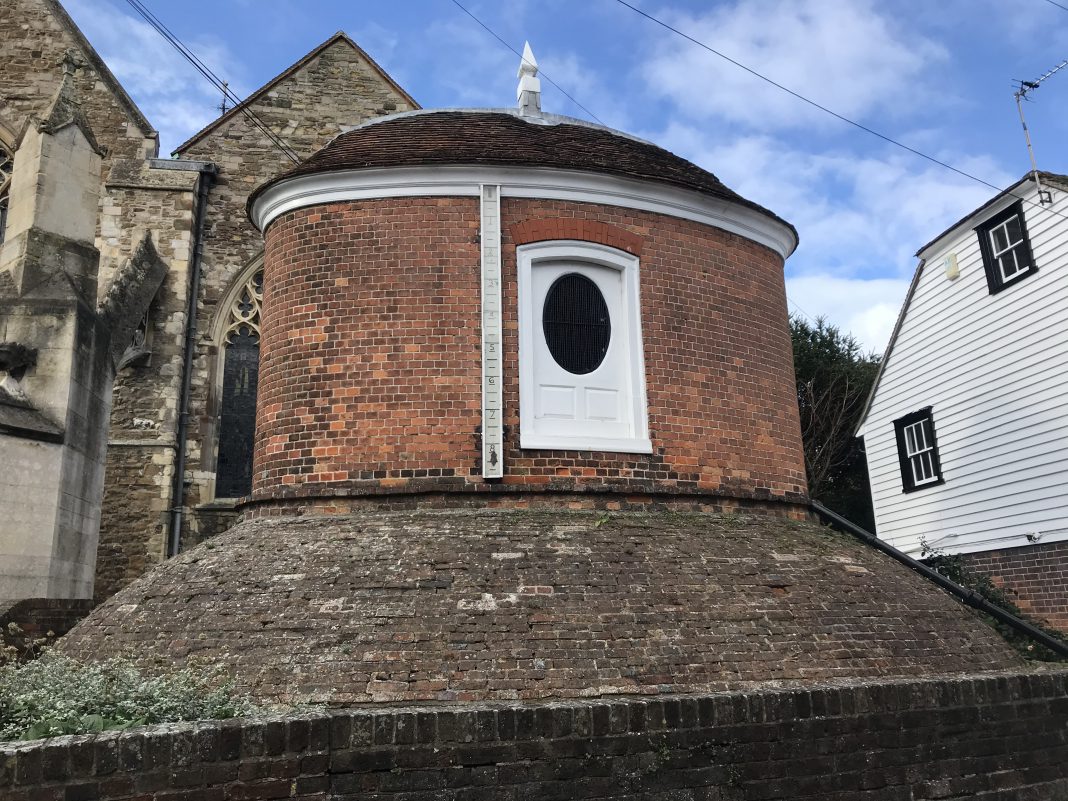Standing in Church Square this Tuesday morning, I overheard a couple who were obviously visiting, chatting about how interesting the buildings are in Rye but in particular Church Square. They were intrigued by the water tower but instead of reading the plaque which gives a brief insight into its history they kept on walking and wondering what it was for and why it was there.
It struck me there may be others who have often seen it but don’t really know any more about it. The photographs show the holding tank, gauge and old hand pump but, as it is listed as a scheduled monument, I thought it best to use an extract from Historic England which should answer all our questions.

“The monument includes a brick cistern or water tower, built between 1733 and 1735. It is situated in the north-east corner of the churchyard of St Mary’s Church on the south-east side of Rye. The red brick cistern is built in two oval shaped sections with a brick vaulted base surmounted by an oval turret. A central hole in the vaulted roof allows access from the turret above. The turret has two rectangular openings on the east and west sides, which contain wooden shutters with oval openings in the centre. It has a tiled roof with a lead ridge and a pointed wooden pinnacle.
“On the east side of the cistern is a glass-fronted measure encased in timber, and at the north-east corner a lead pipe runs down to the adjacent hand pump. The timber cased hand pump has a cast handle and lead framed spout and is inscribed ‘RC 1826’. The cistern is set within a walled enclosure with a brick pathway approaching it.
“The cistern formed an important part of the water supply system of Rye in the 18th century. Water was piped into the town from the north-east to a water house on Cinque Port Street. From here it was pumped, by means of a horse gin dating from 1718, in an elm pipe up Conduit Hill to the cistern. The cistern was sited at the highest point in the town and could hold about 20,000 gallons, which were distributed through wooden pipes to properties in the upper parts of Rye. It is Grade II* listed.”
Reasons for Scheduling
“The provision of clean water has been seen as a public responsibility since early times. The earliest water-supply systems in Britain were built during the Roman period. Aqueducts supplied civil and military centres from wells, springs and impounded sources. Medieval water systems were constructed for monasteries as early as the twelfth century, and similar conduit systems were built for some medieval towns. Early supplies depended on gravitational flow from a spring to a conduit head. Most medieval towns were supplied by at least one well or spring.

“Some conduits, such as that at Exeter in the 14th and 15th centuries, were laid underground, whilst others, such as Wells, ran in the street. Water towers or cisterns were designed to act as a buffer between later pumping stations and the consumer, and to pressurise the mains. Cast iron water tanks first appeared in England in the 1820s although in the mid-19th century the majority of towers were still constructed of brick or stone.
“Rye cistern is in a very good state of preservation. It is a finely crafted vernacular structure, representing a stage of evolution midway between a medieval conduit head and modern storage reservoir. As a monument accessible to the public it also forms an educational and recreational resource.”
Source: Historic England
Image Credits: Nick Forman .



